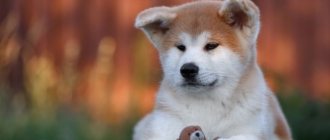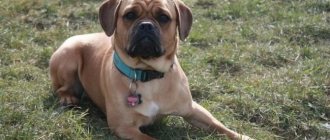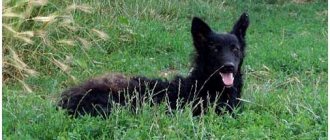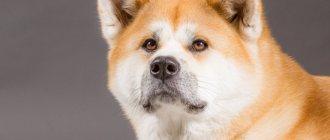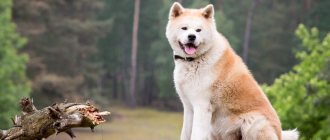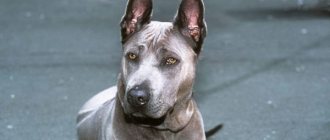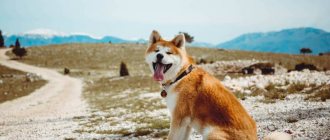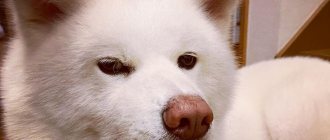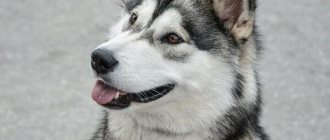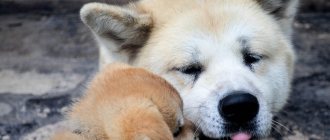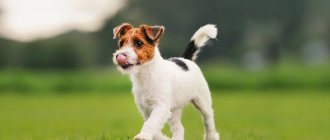- Pets
- >>
- Dog breeds
* Here is a photo of a typical representative of the American Akita dog breed . You can send us photos of your animals by email, and we will post them on the website. Don't forget to send your pet's name.
Other breed names:
Large Japanese dog
Video
* We invite you to watch a video about the American Akita . In fact, in front of you is a playlist in which you can select and watch any of 20 videos about a given dog breed by simply clicking on the button in the upper right corner of the window. In addition, the material contains quite a lot of photos. By looking at them you can find out what an American Akita looks like.
In this article:
|
Tips for choosing a puppy
Opt for trusted kennels with good reviews or experienced breeders registered with the kennel club. Buying secondhand is fraught with deception and purchasing a mixed breed for the price of a purebred puppy.
If you are in doubt about how to choose a healthy and purebred puppy, follow simple rules:
- Choose the most active one. Lethargy is an alarming symptom of many diseases.
- Inspect the exterior carefully. You can first seek advice from the owner of an American Akita or watch a video on the Internet. Make sure that the coat, eyes and ears are in good condition and are in good condition. A puppy that is too potbellied may be infected with helminths.
- Meet the parents. Meeting adult animals will help you learn the character of your future pet. Dogs that are aggressive or cowardly are more likely to pass on their genes to their offspring.
The cost of American Akita puppies often depends on the class, which determines whether the exterior meets approved standards. Before purchasing, think about the purpose of purchasing your future pet. In some cases, this can save money. Regardless of the chosen class, the seller must provide:
- a puppy card containing basic information about the animal;
- a pedigree confirming the breed and demonstrating all possible ancestors;
- veterinary passport used to show all vaccines received.
In addition to basic documents, a purchase and sale agreement must be drawn up for the puppy, guaranteeing the legality of the transaction.
History of the origin of American Akitas
The actite breed is the oldest breed in Japan. The dog has long played the role of a fearless watchman. It was also used for hunting bears and wild boars. Ancient Akitas drove the animal and distracted it from the hunter. The animal was distinguished by its intelligence and intelligence, so it coped with the task perfectly well.
Interesting fact: Akitas participated in dog fighting. In order for representatives of this breed to win leading places in fights, breeders crossed their pets with other strong breeds.
In the 20th century, the number of Japanese Akitas decreased significantly. Dog fighting has lost popularity, and keeping Akitas at home has become unfashionable. The Second World War began, during which dogs began to be taken for service. In addition, in times of famine, the Japanese used these dogs as food.
After the end of the war, dogs were brought to America. During the occupation, American soldiers really took a liking to fluffy dogs. Returning home, they grabbed several Japanese Akitas as a trophy. Thus began the history of the American Akita breed.
From that moment on, the paths of the Japanese and American Akitas diverged. From the imported Akitas, over time, dogs of the “Great Japanese” breed were bred, which in 2001 became known as the American Akita. For this purpose, the Japanese Akita was crossed in America with larger dogs: bullmastiffs, English mastiffs, German shepherds. Therefore, the American breed exceeds the Japanese in size.
The Japanese Akita Club to this day has not officially recognized the American Akita breed and does not give permission to crossbreed its pets with American ones.
Attitude towards people and animals
The American dog rarely shows aggression towards humans. They will never harm their owner if they are treated well. The animal is indifferent to strangers and at first tries to stay away.
American Bully: characteristics of the dog breed
Owners note the main advantage of the dog - its calm and quiet disposition. The animal will not constantly bark and whine. The Akita gives its voice in case of danger or the presence of a nearby source of irritation. Do not be afraid to bring guests into the house, as the dog will react to them in the same way as to the owner. When a person is happy, the pet feels comfortable.
Important! Despite a calm relationship with humans, a dog can show aggression towards other animals. For this reason, it is not recommended to have other pets in the house with an adult dog. The exception is the case when an Akita and another pet grow up together from childhood.
Akita contact with the following animals is strictly prohibited:
- cat;
- rabbit;
- hamster.
A dog can feel in small pets its prey, which it needs to hunt.
The breed does not tolerate long separation from its owner
American Akita - description of the breed
The American Akita, although descended from the Japanese Akita breed, is different in appearance. The American breed is significantly larger than its parent. In addition, the variety of shades of its fur is much wider. The head of the American Akita is larger and wider than the head of the Japanese dog.
The Akita from America is a large dog. Cables reach an average height of 70 cm with a weight of 60 kg, and females - 65 cm with a weight of 45 kg. A distinctive feature of Akitas is their wide, heavy bones.
The standard characteristics of the breed are:
- Small brown eyes;
- Black nose. The exception is a brown lobe in dogs with white fur;
- Small ears that always stand straight with a slight tilt forward;
- Strong muscles;
- Wide strong neck;
- Massive strong paws, which are located parallel to each other. The pads on the paws are fleshy;
- A large fluffy tail, always curled into a ring;
- The coat is thick with excellent undercoat. The head and paws are covered with hair, which is slightly shorter than the body;
- Various coat colors. Moreover, the color of the six and the undercoat can either coincide or differ.
Popular colors of American Akitas
According to the breed standard, the color of a dog can be very diverse: white, fawn-white, red and brindle. There are individuals that are spotted in color and have masks on their faces. Only white dogs are found without a mask. The mask can be replaced by spots on the face or rips.
Fun Fact: White Akitas have black lips, nose and paw pads. With this combination of colors, the animal resembles a soft toy.
The color of the American Akita is clear and clean. If there are spots, their contours are clearly defined, and they are located evenly over the dog’s body. The color of the coat and undercoat does not have to be the same shade.
The main coat colors of dogs of this breed are:
- Solid white. The coat is uniformly dyed snow-white, without any spots or masks. Black lips, nose and paw tufts. The color of the undercoat may differ from the color of the coat: it may be lighter or darker;
- Pinto. The white coat has spots of a different color. The spots occupy 1/3 of the dog's entire body. There is no mask on the face;
- Pale yellow. Six of any light color other than yellow or red. There may be a black mask on the muzzle;
- Brindle. Coat with dark transverse stripes on a base color of yellow, fawn, brown or gray.
There are also other colors of the American Akita: silver-white and silver-black, gray-white, brindle-red, red-white, white-black. They are not as common as the main colors, but the breed standard requires their presence. The most common dogs are snow-white.
Appearance of the breed
American Akita puppy
The American Akita is a very large dog. Strength and power can be read in her every movement. Gradually, the hunting skills of these dogs are becoming a thing of the past, which is largely due to their large size, which prevents the overseas “Japanese” from remaining fast and agile hunters.
Thanks to its special appearance features, namely its spectacular color and perfect lines, the American Akita has long been “registered” at dog shows in different countries of the world, including Russia. Representatives of the breed often lead in BESTS of the fifth group, often winning entire competitions.
general description
It is very difficult to confuse an American Akita with another breed - it is almost impossible, even if before “personal acquaintance” you had only seen it in a photo. The first thing that will catch your eye, in addition to its impressive size, is its strong body with well-developed muscles and massive bones. The “bear” type muzzle with small eyes and a relatively short bridge of the nose will definitely attract attention.
The height and weight of the American Akita, as well as the proportions of the body, vary depending on gender. The height of males at the withers varies from 66 to 71 cm, females - from 61 to 66 cm. The weight of adults is usually: males 45-65 kg, females 32-45 kg.
For males, the ratio of the height at the withers to the length of the body is 9:10, for females it is 9:11. The distance from the foot to the tip of the nose correlates with the distance from the foot to the occipital protuberance in a ratio of 2:3.
Head
American Akita muzzle
The head is the hallmark of the breed. Massive, but at the same time in harmony with the body. There are no skin folds (wrinkles) - provided that your pet is in a calm state. When viewed from above, the shape of the head resembles an obtuse triangle.
The skull is wide and flat, with a shallow groove running upward along the forehead. The transition from forehead to nose (stop) is well expressed, but not sharp.
Wide and voluminous muzzle with powerful, square-shaped jaws. The suspension of the jaws is light. The ratio of muzzle length to skull length is 2:3.
Teeth
The bite is characterized as a regular scissor bite. However, the breed standard also allows for a straight bite. The teeth are strong, the dental formula must be completely present.
Eyes
The Akita's eyes are small, almost triangular in shape, and deep-set relative to the size of the head. Color – dark brown. The eyelids are black and fit tightly.
Ears
The ears are also small in relation to the rest of the head.
Standing, triangular in shape. They have a wide base on strong cartilage, slightly rounded at the ends. The setting is not too low. Above the eyes, at the level of the scruff of the neck, slightly tilted forward. When pulling the ear forward, its tip should ideally touch the edge of the upper eyelid. If you look at the Akita's ears from the side, they seem to continue the top line of the neck.
Nose and lips
The nose is black, wide, the nostrils are well open. Liver color is allowed, but only the American Akita is white. Although it is still preferable to “classic” the breed, that is, the black color of the nose.
The lips are also black, dry, and fit tightly. The tongue is pink.
Neck
Massive, thick and relatively short, with minimal dewlap. Muscular, widening towards the shoulders. The scruff has a good convexity, smoothly passes into the base of the skull and merges with it.
Frame
The body length of the American Akita exceeds the height of the dog at the withers. The chest is wide, voluminous and deep.
The depth of the chest is equal to half the height of the animal at the withers. The ribs are distinguished by sufficient convexity (arched).
The belly is moderately tucked. The back is straight, the lower back is muscular and strong, with a slight convexity. The skin is elastic and fits tightly.
Tail
Covered with straight, thick and coarse hair, it does not form a dewlap. Its base is large and powerful. The tail is set high and the Akita carries it over its back. Or, as an option, the tail touches the side. The tip must reach the back or fall below its level.
The tail is bent into a ring, sometimes double, forming three-quarters of a circle. The last vertebra, when fully rotated, reaches the hock joints.
Limbs
The forelimbs have powerful bones and look straight when viewed from the side. Shoulders moderately sloping back, strong and firm. Elbows should look strictly back, not turned outward or inward. The pasterns have a slight slope, about 15 degrees to the vertical. The paws are round in shape, “cat” type, the direction is straight. The pads are thick and elastic, the fingers are arched with strong claws.
The hind limbs are also distinguished by strong bones and powerful muscles. Hips are well developed and strong. The metatarsals have a fairly low location and are not turned outward or inward. The knee joints, when viewed from behind, are parallel and characterized by moderately pronounced angles. Paws are straight-directed, with elastic pads, round ("cat" type). The fingers are convex (arched) and equipped with strong claws. The so-called dewclaws, that is, the fifth in a row, are usually removed.
The American Akita's gait is characterized by strong, free movements. They are also distinguished by a moderate lunge and push. The movement of the front and hind limbs is carried out in the same plane.
Wool
The coat is double and has a dense undercoat. The guard coat is coarse and straight, while the undercoat is soft and dense and somewhat shorter in comparison with the outer coat.
The hair on the head, ears and limbs is short. Its length at the rump and withers is approximately 5 cm, which is slightly longer than on other parts of the body, with the exception of the tail. It has the longest and most abundant fur – over 6 cm.
Color
White American Akita
The breed standard here is very democratic, allowing any color options, including white, fawn-white, red and brindle. American Akitas can even be piebald, that is, spotted (pinto) - with or without a mask. Instead of a mask, there may be a spot on the forehead or a dent on the muzzle. The mask is completely eliminated only in white individuals. White individuals have black lips, nose and pads.
The colors of dogs of this breed are clear and pure. The spots have clear contours and are evenly spaced. In the Pinto, the spots on a white background are evenly distributed, covering the head and more than one third of the dog's body; a dark-colored mask is allowed.
The color of the undercoat may differ from the coat color.
Possible defects
- Absence of any tooth, with the exception of 2 PM-1 and/or M3.
- Short tail.
- Light eyes.
- Males of the bitch type and, accordingly, bitches of the male type.
- The tongue is blue or with black spots.
- The presence of a collar or fringes.
- Turning of the elbows (inward or outward).
- Anger or, conversely, timidity.
- Lightweight frame.
- Insufficient body weight.
Disqualifying faults
- Partially or completely absent pigmentation of the nose (the so-called butterfly nose).
- Overshot or undershot.
- Semi-erect or completely drooping ears, with folds.
- The tail is straight or crescent shaped.
- The height of males at the withers is less than 63.5 centimeters, and that of females is less than 58 cm.
- Aggression or cowardice.
Any obvious physical abnormalities or problematic behavior is grounds for disqualification of the American Akita.
Please note: male dogs must have two healthy, developed testes, fully descended into the scrotum.
Character and habits of American Akitas
An important distinguishing character trait of this breed is independence. To fully raise a dog, you need to put in a lot of effort and perseverance. To do this, the owner will have to be patient and also find an individual approach to his pet. Rushing in this matter will not help, because the Akita usually cannot withstand long-term training.
Interesting fact: The dog's character is even and flexible. Akita is easy to train, although it trains without much enthusiasm.
The main task of the owner is to make the puppy understand that the owner is not only the main one, but also the most important in the pet’s life. Akita is an independent and proud dog, so you need to immediately point out its place in the house. Moreover, you need to educate her from the moment she appears in the house.
A dog of this breed, despite its large size, can be kept both in an apartment and in the yard of your own house. It does not harm or damage the owner’s property. The dog's independence and independence is manifested in his love of freedom.
At the first opportunity, an Akita may try to run away from its owner. The Akita will prepare for its escape in advance: by digging tunnels or looking for a place where it can jump over the fence. Dogs of this breed are characterized by an increased sense of jealousy, so in the same territory it is difficult for them to get along with other animals, especially dogs.
At home, the Akita's behavior resembles that of a cat. This is an affectionate and almost silent animal. They bark extremely rarely. They behave actively while walking. Since your pet is constantly trying to escape, you should never let him off the leash while walking.
Akitas do not like to fight, so, as a rule, they do not get into a fight first. However, in the event of an attack by another dog, they will be able to give a worthy rebuff. If necessary, the animal will stand until the end.
The watchdog qualities of dogs of this breed are inherited. Akitas make excellent watchdogs and guards. But proper upbringing of a pet will make it a peace-loving and patient family member who will love its owner endlessly.
Key points in training
When training, it is worth remembering that the dog has a strong and independent character, so training should begin as early as possible, while showing calm and perseverance.
- The dog responds to aggression with aggression, so under no circumstances should you raise your voice, hit the Akita, or look directly into the eyes. You need to talk to your pet in a calm tone.
- Food rewards do not work on representatives of this breed; you need to look for an individual approach to your pet.
- Akita will not tolerate monotonous and boring training - it is better to present training in the form of a game.
- You should not force your dog to engage in physical activity if it is tired or uninterested.
- You should not allow the dog to jump on a person, butt heads or demand attention - otherwise the Akita will stop obeying.
If you do not have confidence in your own abilities, it is better to entrust the dog to a professional trainer.
Read about how to properly train a dog in the article: “Training a puppy: effective methods from dog handlers, learning commands at home.”
Interesting facts about American Akitas
Akita is a representative of the most ancient breeds of Japan. During excavations, archaeologists found clay figurines of dogs similar to Akitas, dating back to the 2nd millennium BC. The first representatives of this breed were used to bait bears. The dogs not only were not afraid of the wild animal, but fearlessly attacked it.
Today, in the land of the rising sun, the Akita dog is one of the seven treasures of the nation. The first American owner of an Akita was a disabled writer. She didn't hear or see anything, so the Akita was her guide. She claimed that her pet was a very affectionate, friendly and loyal dog.
At the moment, the American Akita and the Japanese Akita are completely different breeds. Over a long period of time, the actions of breeders in selecting breeds were completely inconsistent, due to the presence of disagreements between clubs. Thus, Japanese breeders tried in every way to purify the breed from impurities of other breeds. But their American colleagues, on the contrary, mixed the breed with others, stronger and more resilient.
The fluffy tail is considered a brand of the breed, and each dog has distinctive features. About two hundred dogs of this breed have received therapy dog status in America.
Most of the planet does not distinguish the American Akita from the Japanese and consider them the same breed.
Americans don't like the official name of the breed - large Japanese dog, so they call it American Akita.
The world famous dog Hachiko is a relative of the Akita. Every year at Shibuitsa station - the place where the dog was waiting for its owner, admirers of this breed hold a holiday in honor of their devoted friend.
Features of feeding and diet
Feeding your pet can be dry or natural. When feeding dry food, choose food of at least super-premium class and follow the standards indicated on the packaging.
If an animal is diagnosed with a disease, then only a doctor will determine which food will be safe and beneficial for the sick person’s body.
When choosing natural food, the dog is fed according to the following proportion:
- meat and offal – 50% of the total diet;
- cereals – 25%;
- vegetables – 25%.
If you doubt whether you can give your animal some controversial product, consult a veterinary clinic. Some foods are not only unhealthy, but also dangerous, regardless of the dog’s age.
When purchasing a puppy through a nursery, the staff will definitely advise you on what to feed the baby until it grows up. Do not try to buy a one-month or two-month-old puppy. At this age, they feed on breast milk, and it is not recommended to separate them from their mother.
The first complementary food is given to puppies older than 2 months. In order to understand how many times to feed your pet, consider its age:
- up to 3 months – 5-6 times a day;
- 3-6 months – 4 times a day;
- 5-12 months – 3 times a day;
- over 1 year – 2 times a day.
Before purchasing, be sure to check with the breeder what kind of food the puppy was fed. A sudden switch to a new brand will cause digestive problems.
Pros and cons of American Akitas
The American Akita breed , like any other dog breed, has both its army of fans and opponents. Some argue that dogs are among the easiest to train animals, so training them is a pleasure. Others say that Akitas cannot be trained.
The main advantages of the breed:
- Loyalty;
- Responsiveness;
- Mental stability;
- Cleanliness.
The American Akita practically does not bark, so it can be classified as a dog that makes virtually no noise.
Negative aspects of the breed:
- Loss of copious amounts of undercoat during shedding;
- Love of freedom;
- Aggression towards other animals and sometimes people.
It is strictly forbidden to leave dogs of this breed alone with children, especially strangers. During active play, a representative of this breed may develop aggression towards someone else's child. A dog may perceive children playing as a threat to its owner and come to his defense.
In order to escape from the owner, and dogs of this breed regularly try to escape because of their love of freedom, they dig tunnels, which significantly damages the landscape of the owner’s yard.
Only an owner with a strong-willed character can raise a companion from this breed. Otherwise, the dog will behave uncontrollably throughout its life.
Who is the dog suitable for?
The American Akita is a dog with a serious character, so it is not suitable for a beginner . Her upbringing requires constant monitoring until the desired behavior is fully consolidated. However, they remember commands easily, and Akitas quickly get used to life in society. They are popular among active people and avid hunters. They need to be taxed mentally and physically, making it difficult for older people to cope with the wayward nature of Akitas.
They behave decently in the family if they know their place in the so-called pack. They stand up to protect property. American Akitas are found in families with children, but due to their large size, it is better to limit their interaction with children for a while.
Hunting sense and working qualities are often the reasons for fights with other dogs , especially of the same sex. They can attack cats, birds, rabbits and domestic rats, thinking about prey. To go outside, prudent owners purchase a muzzle .
The best housing for an American Akita is a private house with a large yard and free range. They are also kept in enclosures, subject to regular exits outside the site.
Representatives of the breed often live in apartments, but for city walks you need to take the upbringing and socialization of your pet seriously.
Can become an excellent security guard . These dogs have a developed sense of smell and are wary of strangers. After guard training, the American Akita will be able to correctly detain or bark an intruder who has entered the owner’s territory.
Breeding American Akitas
The decision to breed American Akitas must be deliberate and balanced. This is a serious test for the breeder and his family members. The American Akita is a dog with a complex character; its puppies must be trained from an early age. Therefore, to get good results, the breeder will have to spend a lot of effort and investment.
Evidence that an Akita female is ready to breed is when she is in heat. It should start in the dog before the first year of life. If there is no heat before 2 years of age, you should consult a veterinarian. After the first heat, the breeder must strictly monitor subsequent heats. On average, an Akita comes into heat 3 times a year.
Important fact: Before breeding dogs, a month before estrus, you should pay special attention to the health of the bitch. Regularly examine the condition of the skin and mucous membranes. The couple should also be dewormed.
As a rule, a bitch should be bred on the 11th-15th day of estrus. To breed, the bitch must be brought to the cable's place of residence. Before mating, dogs should be given a good walk and not fed. A couple of dogs need to be introduced to each other a couple of weeks in advance. To do this, the dogs must go for walks together several times. After this, the bitch must accept the partner's advances. Otherwise, the dogs will have to be bred forcibly.
Usually, after a successful mating, pregnancy occurs within 3 days. There are cases of false pregnancy, then you should seek help from a veterinarian. Pregnancy usually lasts 2 months. To the naked eye, signs of pregnancy are visible only at the beginning of the second month. There are cases that due to hormonal changes, the bitch begins to behave unusually from the first days.
While the bitch is pregnant, she requires special care. Firstly, her diet should be high in calories and fortified. Secondly, you now need to walk your dog more often, but more calmly. On average, she should travel no more than 6 km per day.
A week before giving birth, the bitch should be moved indoors if she previously lived in the yard. Typically, an Akita litter will produce 6 or 8 puppies. After the end of labor, the bitch must be closely monitored during the first 24 hours.
Education and training
Despite its devotion, the Akita is characterized by dominance. Before purchasing a new family member, learn how to raise one.
Education and training of the American Akita should include:
- Systematicity. Inexperienced owners doubt whether it is possible to train a small puppy. If you want to raise an obedient dog, regularly conduct basic training from the day it arrives in the house. Before vaccinations, be sure to train your puppy to toilet in a diaper and never allow him to chew on old shoes if you don’t want to say goodbye to new ones.
- The authority of the owner. Training an Akita threatens complete failure for a weak-willed owner or a small child. Never give in when communicating with your pet and follow the rules regarding prohibitions. Otherwise, you will have to rack your brains to figure out how to wean your dog from sleeping on the bed.
- Interest. The pet quickly loses interest in the monotonous process, refusing to perform boring exercises. Conduct training in a game format and be sure to reward the correct actions.
Double-layer wool allows you to train your Akita outdoors in both cold winter and hot summer. During street training, remember about safety. From mid-spring to mid-autumn, be sure to treat your dog for ticks.
Avoid corporal punishment and yelling. Even a well-mannered dog can become willful. This is inherent in his character and is ineradicable, but there are ways of gentle influence:
- Pressed to the floor. Press down on the dog's back. Act confidently, but carefully so as not to hurt your pet. Hold the position until the resistance is relieved.
- Grabbing by the withers and then pressing to the floor. If you don’t know how to train a stubborn puppy to obey, then this method will come in handy. This is what mothers use when trying to reason with their naughty four-legged babies. Please note that it is prohibited to pick up adult dogs by the withers. Heavy weight can injure their vertebrae.
A trained dog is a guarantee of the safety of the owner and the people around him. If you have problems with education, be sure to seek help from a dog trainer and sign up for classes.
Looking for an American Akita? Find your pet from 1 offer As a gift
Caring for American Akitas
The American Akita is a rather unpretentious animal. But like any dog, it requires care and attention. The lifespan of a pet largely depends on the living conditions.
The thick coat of the Akita is not prone to matting, so tangles do not form on it. There is no need to cut the actite, but it is necessary to comb it often in order to comb out the undercoat in a timely manner. It is advisable to carry out the procedure with a metal brush twice a week. The undercoat must be combed out as necessary during the animal's seasonal shedding.
The dog's eyes need to be examined daily. Small gray lumps of nitrous oxides that form in the corners of the eyes must be removed with a clean, dry cloth. In case of excessive souring, swelling or redness, it is necessary to promptly contact a veterinarian. Self-medication of an animal is dangerous.
Important fact: Your pet's ears need to be examined once a week. Healthy ears have a uniform pink color without rashes, there is no excess wax, and there is no unpleasant odor. To avoid the formation of tartar, the dog needs to brush its teeth every other day with a special toothpaste using a toothbrush or a special finger attachment.
There is no need to bathe the animal after a daily walk. It is enough to wipe the fur with a dry cloth and wipe or wash the paws. In this case, it is necessary to inspect the bundles for the presence of cracks. To avoid dry paw pads and the formation of cracks on them, you should rub vegetable oil into them. Experts also advise adding it to your pet’s diet.
If necessary, your Akita should have its nails trimmed. To prevent hangnails from forming as a result of the procedure, nails must be filed with a nail file after trimming. The American Akita is a very active and energetic animal, so it needs regular walks in the fresh air. The dog owner will have to spend a lot of time actively playing with the animal.
Mating
- In female Akitas, their first heat occurs between 8 months and one year of age. On average, it lasts two to three weeks and is repeated every six months.
- To give birth to healthy puppies, you should prepare for breeding in advance . The owner of the bitch needs to keep a diary in which the dates of estrus, the condition and behavior of the dog will be recorded.
- Before the intended mating, a month and a half before, you should be examined for the presence of infectious diseases, dewormed and vaccinated with a polyvalent vaccine.
- Animals must be introduced before the onset of heat and the reaction of the bitch to the male must be observed.
- Before mating, your pet should not be overfed , as this will have an adverse effect on pregnancy. In this case, the dog should not be too thin, otherwise a miscarriage may occur.
American Akita diet
Today, the concept of healthy and natural food for dogs is quite vague. It is very difficult to buy truly natural food, so dry food was created as a way out of this situation. Food with all the necessary additives and components, for dogs of all types, sizes and ages.
An American Akita puppy will be well suited to premium food for his age category. Considering all the vitamins and nutrients contained in the food, it can safely be considered a complete nutrition.
But if you stick to the option of natural food, then at first the American Akita puppy can be fed with low-fat cottage cheese, kefir, boiled eggs, boiled chicken and fish. American Akita puppies love fruits, so it’s worth finding out what kind of fruits your baby likes and including them in his diet.
From childhood, puppies should be taught a routine and feeding according to a schedule. By the age of 6 months, an American Akita puppy should eat three times a day, and by nine months, switch to two meals a day. It is necessary to control the amount of food your puppy eats. If some of the food remains in the feeder, then it is necessary to remove it and not give the opportunity to finish eating later, and the portion should also be reduced.
Important fact: The puppy must get used to eating in one go. If the puppy licks the plate for a long time after eating, it is worth increasing the portion slightly, since he is not full.
Leading dog experts unanimously declare that chicken bones, raw fish, fatty foods, sweets and yeast products should be excluded from the dog’s diet. All these products are not beneficial, but only burden the digestive system or cause harm. Adult American Akitas should be fed twice a day.
Premium food or natural food are also suitable for feeding. The main thing is not to mix them with each other. Fruits should be given to your dog at the end of a meal, as a dessert.
How to choose a puppy
You should buy an American Akita puppy from trusted breeders who have been on the market for several years. It would be useful to find all possible information about the seller on the Internet and read reviews. An experienced breeder who values his reputation will definitely tell you which puppy is best for you. Some need a good hunter, others need a potential winner of all possible exhibitions, and others just need a good and faithful friend for themselves and their children, and to protect the house.
American Akita puppy with mom
Be sure to look at the parents of the future pet. This is very important because the offspring inherits their appearance and behavior. If it turns out that the mother or father is cowardly or, conversely, aggressive, then the puppy you choose may very likely turn out to be the same.
Be sure to pay attention to the appearance of the American Akita puppy. He should have shiny fur that is soft to the touch. While petting such a puppy, an association with a plush toy involuntarily arises. If he is too thin, has a swollen tummy, red and watery eyes, or twisted elbows and knees, then it’s better not to take risks and don’t take it. You should not take a puppy that is too young in age, since professionals do not assign show classes to dogs under 9 months.
Your future pet should be active. Lethargy in behavior is a sign of depression, which in turn may indicate a particular disease. If possible, to rule out hidden illnesses that may manifest themselves in the future, pay attention to the puppy's feces. Its consistency and color may confuse you. In this case, you should refrain from purchasing.
Diseases and health problems
Representatives of the American Akita are naturally quite healthy and endowed with strong immunity. Puppies of this breed differ from most others in that they are not susceptible to infections. But still, there are diseases that representatives of this breed transmit to each other at the genetic level: hip dysplasia, progressive retinal atrophy, epilepsy, bloating, entropion and eversion of the eyelids, infertility.
Hip dysplasia in the American Akita develops due to the increased physical activity that the dog is exposed to during its maturation stage, as well as due to poor nutrition. Yes, even if there is a genetic predisposition, the disease can be circumvented if you monitor the puppy’s diet and also dose his physical activity.
Akitas often have problems conceiving. Infertility problems can arise due to hormonal imbalance. Also, representatives of the American Akita may have various types of allergies, seborrheic adenitis, hypothyroidism, dermatitis, gastric volvulus, pemphigus, intolerance to anesthesia, Cushing's syndrome.
Hypothyroidism often occurs in dogs due to problems with the thyroid gland. The disease is transmitted through the maternal line. Previously, dogs were euthanized because of this disease. Now the disease is easily curable. American Akitas live from ten to fourteen years, but this is subject to proper care, proper nutrition and timely vaccinations.
